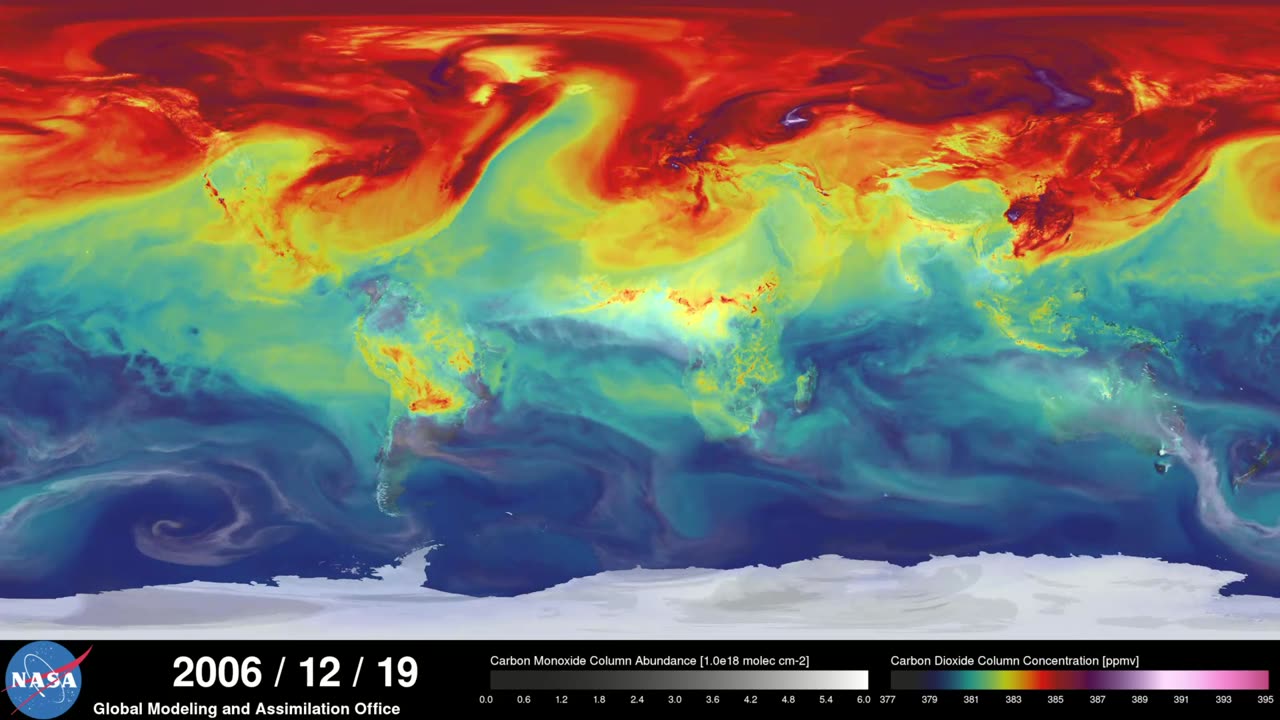Premium Only Content

A Year In The Life Of Earth’s CO2 PART 3
An ultra-high-resolution NASA computer model has given scientists a stunning new look at how carbon dioxide in the atmosphere travels around the globe.
Plumes of carbon dioxide in the simulation swirl and shift as winds disperse the greenhouse gas away from its sources. The simulation also illustrates differences in carbon dioxide levels in the northern and southern hemispheres and distinct swings in global carbon dioxide concentrations as the growth cycle of plants and trees changes with the seasons.
The carbon dioxide visualization was produced by a computer model called GEOS-5, created by scientists at NASA Goddard Space Flight Center’s Global Modeling and Assimilation Office.
The visualization is a product of a simulation called a “Nature Run.” The Nature Run ingests real data on atmospheric conditions and the emission of greenhouse gases and both natural and man-made particulates. The model is then left to run on its own and simulate the natural behavior of the Earth’s atmosphere. This Nature Run simulates January 2006 through December 2006.
While Goddard scientists worked with a “beta” version of the Nature Run internally for several years, they released this updated, improved version to the scientific community for the first time in the fall of 2014.
Hi, this is Bill Putman. I'm a climate scientist at NASA's Goddard Space Flight Center. What you’re looking at is a supercomputer model of carbon dioxide levels in the Earth’s atmosphere. The visualization compresses one year of data into a few minutes. Carbon dioxide is the most important greenhouse gas affected by human activity. About half of the carbon dioxide emitted from fossil fuel combustion remains in the atmosphere, while the other half is absorbed by natural land and ocean reservoirs. In the Northern Hemisphere, we see the highest concentrations are focused around major emission sources over North America, Europe and Asia. Notice how the gas doesn’t stay in one place. The dispersion of carbon dioxide is controlled by the large-scale weather patterns within the global circulation. During spring and summer in the Northern Hemisphere, plants absorb a substantial amount of carbon dioxide through photosynthesis, thus removing some of the gas from the atmosphere. We see this change in the model as the red and purple colors start to fade. Meanwhile, in the Southern Hemisphere, we see the release of another pollutant—carbon monoxide. This is a gas that’s both harmful to the environment and to humans. During the summer months, plumes of carbon monoxide stream from fires in Africa, South America and Australia, contributing to high concentrations in the atmosphere. Notice how these emissions are also transported by winds to other parts of the world. As summer transitions to fall, and plant photosynthesis decreases, carbon dioxide begins to accumulate in the atmosphere. Although this change is expected, we’re seeing higher concentrations of carbon dioxide accumulate in the atmosphere each year. This is contributing to the long-term trend of rising global temperatures. The Orbiting Carbon Observatory-2, or OCO-2, will be the first NASA satellite mission to provide a global view of carbon dioxide. OCO-2 observations and atmospheric models like GEOS-5 will work closely together to better understand both human emissions and natural fluxes of carbon dioxide. This will help guide climate models toward more reliable predictions of future conditions across the globe.
-
 LIVE
LIVE
Phyxicx
5 hours agoLast minute practice before Sunday - 4/26/2025
225 watching -
 LIVE
LIVE
The Official Steve Harvey
10 days ago $4.05 earned24 HOURS OF MOTIVATION w/ STEVE HARVEY
55 watching -
![Nintendo Switch It UP Saturdays with The Fellas: LIVE - Episode #16 [Clue]](https://1a-1791.com/video/fww1/eb/s8/1/L/3/n/F/L3nFy.0kob-small-Nintendo-Switch-It-UP-Satur.jpg) LIVE
LIVE
MoFio23!
10 hours agoNintendo Switch It UP Saturdays with The Fellas: LIVE - Episode #16 [Clue]
73 watching -
 LIVE
LIVE
StaleSavage
2 hours ago"MASTER PRACTICE"
29 watching -
 39:29
39:29
Stephen Gardner
4 hours ago🔥Pam Bondi drops NIGHTMARE NEWS on 3 top DEMOCRATS!
47.3K88 -
 31:26
31:26
The Brett Cooper Show
2 days ago $16.93 earnedI Spoke With People Close To Justin Bieber | Episode 25
44.3K82 -
 1:08:48
1:08:48
Winston Marshall
1 day agoThe Damaged Generation: How Lockdown Damaged 50 Million Children For Life with David Zweig
68.9K75 -
 LIVE
LIVE
Eternal_Spartan
9 hours agoLive at 11am Central!! | Clari Obscur Expedition 33 - Possibly the Best Game of My Life?!?
147 watching -
 13:05
13:05
Cowboy Kent Rollins
1 day ago $12.79 earnedHomemade Cowboy Corn Dogs | Easy Corndog Recipe
65.2K28 -
 6:26:31
6:26:31
GritsGG
8 hours ago#1 Warzone Win Grind! 🔥
39.1K6